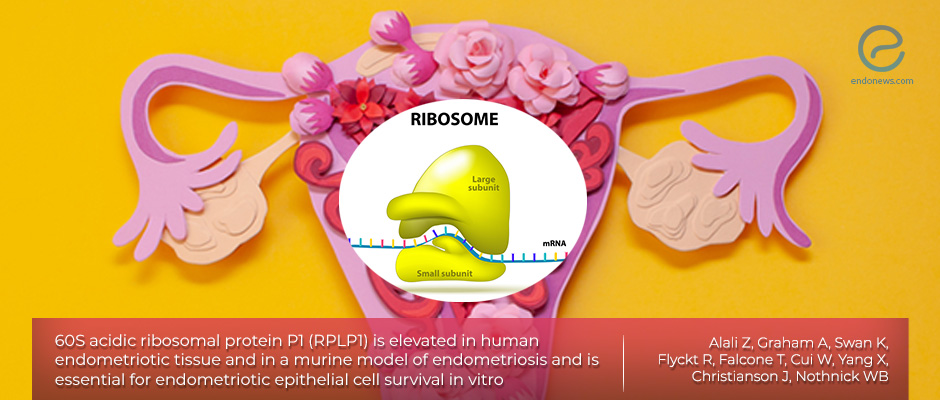The role of acidic ribosomal protein P1 in Endometriosis
Feb 19, 2020
This protein seems to be essential for endometriosis epithelial cell survival
Key Points
Importance:
- Dr. Nothnick group suggests that RPLP1 is associated with cell proliferation and it may play a role in the pathophysiology of endometriosis.
Background:
- Estrogen-related factors are critical for endometriosis development and progression, but we have a limited understanding of the complexity of the environment.
- RPLP1 is part of the 60S ribosomal subunit which functions in regulating protein synthesis and expression is regulated by the estrogen target gene c-Myc.
- It is overexpressed in gynecologic cancers, including endometrial cancer, but the function has not been well studied.
Key points:
- RPLP1 is localized to the glandular epithelium in eutopic and ectopic tissue from women with endometriosis.
- The level of RPLP1 mRNA and protein is elevated in endometriotic lesions, and it correlates with a lesion proliferation marker, cyclin E1.
- The knockdown of RPLP1 in endometriotic epithelial cell line resulted in a significant reduction in the number of viable cells, and this supports the functional importance of RPLP1 in endometrial epithelial cell survival.
- In a mouse model with experimentally-induced endometriosis, the level of RPLP1 expression is significantly higher in the mice with endometriosis than the control.
Conclusions:
- The above results suggest that RPLP1 is associated with cell proliferation and/or survival and it may play an important role in the pathophysiology of endometriosis.
Lay Summary
Endometriosis is an estrogen-dependent disorder. The disease develops and composed of the ectopic endometrial-like tissue which establishes primarily in the pelvic cavity. Previous findings clearly show that estrogen-related factors are critical for endometriosis development and progression. However, we do have a limited understanding of the complexity of the environment.
RPLP1 is part of the ribosomal subunit which functions in regulating protein elongation translation factors. Interestingly, its expression is regulated by the estrogen target gene, c-Myc. According to previous research, RPLP1 is associated with cell proliferation and survival. Also, it is overexpressed in gynecologic cancers, including endometrial cancer.
As both endometrial cancer and endometriosis are highly dependent on estrogen, the Dr. Nothnick group decided to evaluate the expression and function of RPLP1 in endometriosis. Furthermore, they examined the association of the RPLP1 expression with lesion survival and pelvic pain using a mouse model for endometriosis. This paper was recently published in the journal named “Molecular Human Reproduction”.
Firstly, the location of RPLP1 was confirmed to be localized to the glandular epithelium in eutopic and ectopic tissue from women with endometriosis. The expression level of RPLP1 was measured. The team found that the level of RPLP1 mRNA and protein are elevated in endometriotic lesions, and its expression correlates with a lesion proliferation marker, cyclin E1. The knockdown of RPLP1 in endometriotic epithelial cell line resulted in a significant reduction in the number of viable cells, and this supports the functional importance of RPLP1 in endometrial epithelial cell survival.
To confirm those data in vivo model, Dr. Nothnick group used a mouse model of experimentally-induced endometriosis. Consistently with the result in human tissue, the level of RPLP1 expression is significantly higher in the ectopic lesion tissue in the mice with endometriosis than the eutopic tissue from the control.
Together, these results suggest that RPLP1 is associated with cell proliferation and/or survival and may play a role in the pathophysiology of endometriosis.
Research Source: https://www.ncbi.nlm.nih.gov/pubmed/31899515
Endometriosis RPLP1 c-Myc proliferation 12Z cell line

